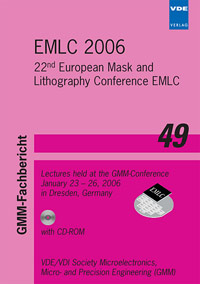Iso-sciatic point: novel approach to distinguish 3-D mask effects from scanner aberrations in extreme ultraviolet lithography
Konferenz: EMLC 2006 - 22nd European Mask and Lithography Conference
23.01.2006 - 26.01.2006 in Dresden, Germany
Tagungsband: EMLC 2006
Seiten: 6Sprache: EnglischTyp: PDF
Persönliche VDE-Mitglieder erhalten auf diesen Artikel 10% Rabatt
Autoren:
Leunissen, Leonardus H. A.; Gronheid, Roel (IMEC vzw, Leuven, Belgium)
Gao, Weimin (Sigma-C Software AG, Munich, Germany)
Inhalt:
Extreme ultraviolet lithography (EUVL) uses a reflective mask with a multilayer coating. Therefore, the illumination is an off-axis ring field system that is non-telecentric on the mask side. This non-zero angle of incidence combined with the three-dimensional mask topography results in the so-called “shadowing effect”. The shadowing causes the printed CD to depend on the orientation as well as on the position in the slit and it will significantly influence the image formation. In addition, simulations show that the Bossung curves are asymmetrical due to 3-D mask effects and their best focus depends on the shadowing angle. Such tilts in the Bossung curves are usually associated with aberrations in the optical system. In this paper, we describe an approach in which both properties can be disentangled. Bossung curve simulations with varying effective angles of incidence (between 0 and 6 degrees) show that at discrete defocus offsets, the printed linewidth is independent of the incident angle (and thus independent of the shadowing effect), the so-called iso-sciatic (constant shadowing) point. For an ideal optical system this means that the size of a printed feature with a given mask-CD and orientation does not change through slit. With a suitable test structure it is possible to use this effect to distinguish between mask topography and imaging effects from aberrations through slit. Simulations for the following aberrations tested the approach: spherical, coma and astigmatism.


